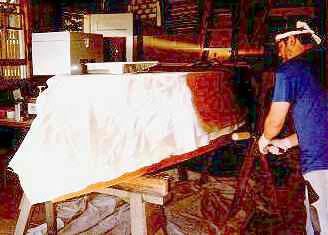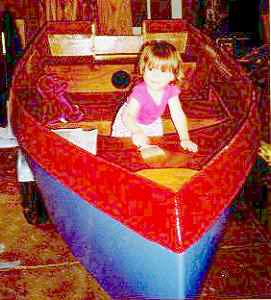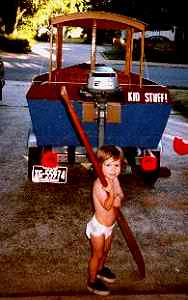Building the Tubby Tug
Page 3
As the 1999 boating season drew closer, I transported the boat back to my parents' house in the back of my truck to apply fiberglass sheathing and paint. The boat fits perfectly in a full-size pickup's bed with the tailgate down, which is a nice feature, although it takes at least two people and preferably four to put the boat in the truck. I will admit to being a bit nervous about fiberglassing the hull, never having done it - but it turned out to be easier than I thought and came out well. I waited until the weather was perfect - temperatures in the low 70s and low humidity, which one often gets in June at the New Jersey coast. After the initial bonding coat, I applied multiple thin coats of epoxy resin activated with slow hardener. I was careful to "work" the resin on the vertical surfaces until it began to set, and did manage to avoid sags and runs. Glen-L's publications and video on fiberglassing were a big help in building my confidence prior to the big event.

By this time, I started backing off my "heirloom quality" approach, at least temporarily, since I wanted to use the boat during the 1999 season. I chose to bypass, at least initially, a lot of the sanding and grinding which would be necessary to really smooth out the overlaps in the sheathing and interior taping. I figured I could always go back and re-finish certain areas, even after the boat was painted. I also chose to delay installing the bumper rail and sheer mouldings, which I was going to make out of red oak. I was careful, however, to seal the plywood edge at the sheer, an area very vulnerable to moisture penetration. I kept the cabin C-clamped to the hull so it could be removed again for further refinements - ultimately it will be bolted and epoxy filleted in place.

My wife and I considered a number of paint schemes for the outside of the hull, and finally landed on one which uses bright, "storybook" primary colors. My daughter has the children's book "Scuffy the Tugboat", so I guess that was part of our inspiration. The paints are off-the-shelf EasyPoxy colors. By the time the paint was on, there was no stopping Emily's eagerness to help, although it was still only pretend.
A big area of indecision involved propulsion. Up until this time, my experience with piloting watercraft had been limited to paddling canoes, of which I did a lot in my teens and twenties, including overnight trips through white water. But I didn't have a very good sense of what kind of outboard power Tubby Tug would require. The specs indicated the maximum power for the design (5 hp), but I wondered if that much power and weight was necessary. And what about electric power? The only thing I knew for sure was that there were strong tidal currents in the area of New Jersey where the boat would often be used (Manasquan Inlet and Barnegat Bay), and that made me a bit leery of relying on an electric trolling motor. The folks at Glen-L indicated that the prototype performed fine with a 3 hp gas outboard, but that was without strong currents or winds.

To make a long story short and leave out a lot of the research I did, we finally opted to buy a 2 hp Honda Four Stroke engine, which has proven to be a great choice, although initially expensive (I think of it as an investment). The 2 hp Honda pushes the boat just fine, is very quiet, and I can also use it as an auxiliary on my next project, when I get around to starting it. Fortunately, I had waited long enough that Honda had just come out with a twist-grip throttle version with a centrifugal clutch for only a few dollars more than the model which didn't have these features. This provides so much control at the tiller that I can maneuver the Tubby Tug as well as I can a canoe with a paddle. A very important consideration was that the Honda 2 hp is the only 4 stroke outboard on the market with an internal fuel tank - something to think about in a small boat with kids aboard. I do plan to get an electric rig this season, at least to use on waters where gas outboards are not permitted.